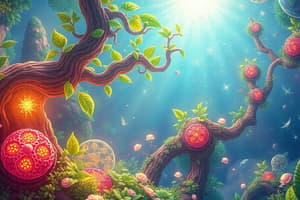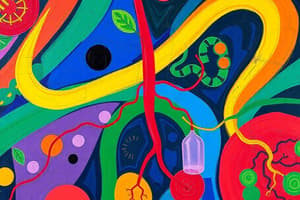Podcast
Questions and Answers
Which type of muscle is found in the heart?
Which type of muscle is found in the heart?
- Striated muscle
- Smooth muscle
- Skeletal muscle
- Cardiac muscle (correct)
Anorexia nervosa is characterized by the excessive intake of food.
Anorexia nervosa is characterized by the excessive intake of food.
False (B)
What is the primary function of calcium in muscle contraction?
What is the primary function of calcium in muscle contraction?
Calcium triggers the contraction of muscle fibers by enabling the interaction between actin and myosin.
____ is a disease characterized by the accumulation of fluid in the lungs, leading to cough and difficulty breathing.
____ is a disease characterized by the accumulation of fluid in the lungs, leading to cough and difficulty breathing.
Match the digestive disorders with their main characteristics:
Match the digestive disorders with their main characteristics:
What is the primary function of chloroplasts in plant cells?
What is the primary function of chloroplasts in plant cells?
ATP is produced during anaerobic respiration.
ATP is produced during anaerobic respiration.
Name the two main stages of photosynthesis.
Name the two main stages of photosynthesis.
The _______ cycle occurs in the mitochondria and produces ATP through a series of reactions.
The _______ cycle occurs in the mitochondria and produces ATP through a series of reactions.
Match the following enzymes with their respective functions in the digestive system:
Match the following enzymes with their respective functions in the digestive system:
Which of the following is a biotic factor in an ecosystem?
Which of the following is a biotic factor in an ecosystem?
Glycolysis produces more ATP than the Krebs cycle.
Glycolysis produces more ATP than the Krebs cycle.
What is the purpose of alveoli in the respiratory system?
What is the purpose of alveoli in the respiratory system?
The _______ is the structure of the heart that prevents backflow during contraction.
The _______ is the structure of the heart that prevents backflow during contraction.
Match the following terms related to the digestive system with their definitions:
Match the following terms related to the digestive system with their definitions:
What is the primary role of hemoglobin in blood?
What is the primary role of hemoglobin in blood?
Fermentation occurs in the presence of oxygen.
Fermentation occurs in the presence of oxygen.
What is biogeochemical cycling?
What is biogeochemical cycling?
The _______ system is responsible for the management of waste and maintaining homeostasis.
The _______ system is responsible for the management of waste and maintaining homeostasis.
Flashcards
Diabetes mellitus
Diabetes mellitus
A condition where the body cannot regulate blood sugar properly, leading to high blood sugar levels.
Lactose intolerance
Lactose intolerance
A disorder where the body lacks the enzyme to break down a specific sugar, leading to buildup of the sugar in the body.
Bronchitis
Bronchitis
Inflammation of the bronchi, the airways that carry air to the lungs.
IBD (Inflammatory Bowel Disease)
IBD (Inflammatory Bowel Disease)
Signup and view all the flashcards
Atherosclerosis
Atherosclerosis
Signup and view all the flashcards
What is ATP and how does it work?
What is ATP and how does it work?
Signup and view all the flashcards
What is the structure of a chloroplast?
What is the structure of a chloroplast?
Signup and view all the flashcards
What is the structure of a mitochondrion?
What is the structure of a mitochondrion?
Signup and view all the flashcards
What is photosynthesis, and how is it summarized?
What is photosynthesis, and how is it summarized?
Signup and view all the flashcards
What is cellular respiration?
What is cellular respiration?
Signup and view all the flashcards
What are the light-dependent reactions of photosynthesis?
What are the light-dependent reactions of photosynthesis?
Signup and view all the flashcards
What are the light-independent reactions of photosynthesis?
What are the light-independent reactions of photosynthesis?
Signup and view all the flashcards
What is the difference between aerobic and anaerobic respiration?
What is the difference between aerobic and anaerobic respiration?
Signup and view all the flashcards
What is glycolysis?
What is glycolysis?
Signup and view all the flashcards
What is pyruvate oxidation?
What is pyruvate oxidation?
Signup and view all the flashcards
What is the Krebs cycle?
What is the Krebs cycle?
Signup and view all the flashcards
What is oxidative phosphorylation?
What is oxidative phosphorylation?
Signup and view all the flashcards
What is fermentation?
What is fermentation?
Signup and view all the flashcards
What is the rule of ten?
What is the rule of ten?
Signup and view all the flashcards
What is biomagnification?
What is biomagnification?
Signup and view all the flashcards
What is nitrogen fixation?
What is nitrogen fixation?
Signup and view all the flashcards
What is nitrogen fixation, and why is it important?
What is nitrogen fixation, and why is it important?
Signup and view all the flashcards
What is binomial nomenclature?
What is binomial nomenclature?
Signup and view all the flashcards
Define evolution
Define evolution
Signup and view all the flashcards
What is speciation?
What is speciation?
Signup and view all the flashcards
Study Notes
Photosynthesis & Cellular Respiration
-
ATP Structure & Energy: ATP (adenosine triphosphate) is a crucial energy carrier in cells. Energy is released when a phosphate bond is broken, and stored when a bond is formed.
-
Chloroplast & Mitochondria Anatomy: Chloroplasts are the site of photosynthesis, while mitochondria are the powerhouses of cellular respiration. Their structures are tailored to their function.
-
Photosynthesis/Cellular Respiration Basics:
- Equations: Photosynthesis: 6CO₂ + 6H₂O → C₆H₁₂O₆ + 6O₂ ; Cellular Respiration: C₆H₁₂O₆ + 6O₂ → 6CO₂ + 6H₂O.
- Location (type of cell): Photosynthesis occurs in plant cells with chloroplasts. Cellular respiration takes place in the mitochondria of all eukaryotic cells.
- Goal: Photosynthesis converts light energy into chemical energy (glucose), while cellular respiration releases stored energy from glucose to produce ATP.
- Energy Molecules: Photosynthesis uses light energy, water, and carbon dioxide to form glucose and oxygen. Cellular respiration uses glucose and oxygen to produce ATP, carbon dioxide, and water.
Photosynthesis
-
Photosystems/Reaction Centres: Photosystems capture light energy using pigments (chlorophyll). Light absorption characteristics are described by their action and absorption spectrums.
-
Light-Dependent Reactions:
- Events: These reactions involve water splitting, electron transport chains, and chemiosmosis to generate ATP and NADPH.
- Location: Thylakoid membranes within chloroplasts.
- Products: ATP, NADPH, and oxygen.
- Electron Transport System: Electrons from water travel along a series of proteins to generate energy for ATP synthesis.
- Chemiosmosis: The flow of protons (H⁺) across the membrane drives ATP synthesis.
-
Light-Independent Reactions (Calvin Cycle):
- Events: These reactions use ATP and NADPH from light-dependent reactions to fix carbon dioxide into sugars.
- Carbon Fixation: Incorporating CO₂ into an existing organic molecule.
- PGAL (glyceraldehyde-3-phosphate): A crucial intermediate in the Calvin cycle, used to produce glucose and other organic compounds.
- Linking light-dependent & independent reactions: The products (ATP and NADPH) of light-dependent reactions are used as energy sources in light-independent reactions.
Cellular Respiration
-
Aerobic vs. Anaerobic Respiration: Aerobic respiration requires oxygen, while anaerobic respiration does not. Anaerobic respiration yields less ATP.
-
Energy Outputs: Aerobic respiration yields a net of 36-38 ATP per glucose molecule. Anaerobic yields significantly less.
-
Glycolysis, Pyruvate Oxidation, Krebs Cycle, and Oxidative Phosphorylation:
- Location: Glycolysis in the cytoplasm; pyruvate oxidation, Krebs cycle in the mitochondrial matrix; oxidative phosphorylation in the inner mitochondrial membrane.
- Oxygen requirements: Glycolysis can occur without oxygen (anaerobic), whereas the other steps require oxygen (aerobic).
- Products: Specific products of each step in each process.
-
Fermentation:
- Types: Ethanol fermentation (e.g., yeast) and lactate fermentation (e.g., muscle cells).
- ATP yield: Fermentation produces significantly less ATP than aerobic respiration.
Ecology
- Radiant Energy in Atmosphere: The amount of solar energy absorbed is influenced by factors such as reflection and albedo.
- Organism Hierarchy: Organisms are part of larger structural hierarchical units, from populations to the biosphere, illustrating complex interactions.
- Limiting Factors (biotic and abiotic): Factors influencing population growth.
- Sampling: Methods for studying ecological communities and populations.
- Food Chains, Webs, and Pyramids: Illustrating energy flow and relationships among organisms.
- Habitat vs. Range vs. Niche: Different ecological concepts clarifying the organism's location and role.
- Biomagnification: The accumulation of toxins in organisms at successive trophic levels.
- Trophic Levels: Positions of organisms within a food chain or web.
- Rule of 10: General guideline for energy transfer efficiency between trophic levels.
- Biogeochemical Cycles: Matter cycling through the biosphere, including water, carbon/oxygen, sulfur, nitrogen, and phosphorous cycles.
- Specific Terms: Nitrogen fixation, evaporation, etc., play crucial roles in these cycles.
- Environmental Impacts: Acid deposition, algal blooms are linked to biogeochemical imbalances.
Classification of Organisms
- Hierarchy: Domain, Kingdom, Phylum, Class, Order, Family, Genus, Species.
- Domains: The three broadest categories of living organisms (Bacteria, Archaea, and Eukarya).
- Binomial Nomenclature: Scientific naming system using Latin genus and species names.
Adaptation vs. Variation
- Types: Structural, behavioral, physiological.
Evolution
- Definition: The change in heritable characteristics of biological populations over successive generations.
- Natural Selection: Organisms with advantageous traits are more likely to survive and reproduce.
- Selective Pressure: Environmental factors that influence the likelihood of survival and reproduction.
- Evidence for Evolution: Fossil records and DNA evidence support evolutionary changes.
- Gradualism vs. Punctuated Equilibrium: Different models of evolutionary change.
Speciation
- Types: Allopatric, sympatric, parapatric.
- Mechanisms: Events that cause speciation to occur.
Other Systems (digestive, respiratory, circulatory, etc.)
Covers detailed anatomy, physiology, and related processes for each system. Provides details on organs and functions including the chemical and physical breakdowns, absorption processes, and related blood flow and gas exchange. Includes diseases (effects, symptoms, treatments).
Studying That Suits You
Use AI to generate personalized quizzes and flashcards to suit your learning preferences.
Description
Explore the essential processes of photosynthesis and cellular respiration, vital for energy transformation in living organisms. Understand the roles of ATP, chloroplasts, and mitochondria, alongside their functions and structures. Test your knowledge of the equations and cellular locations involved in these processes.




